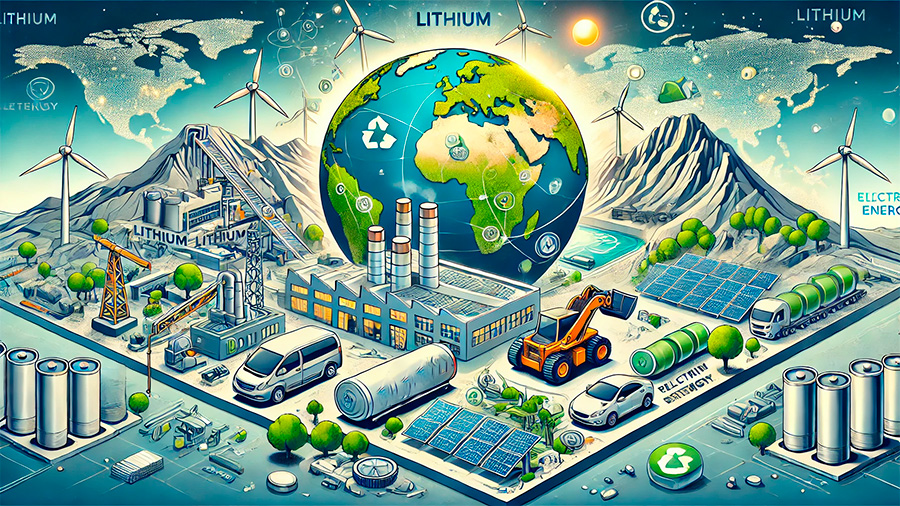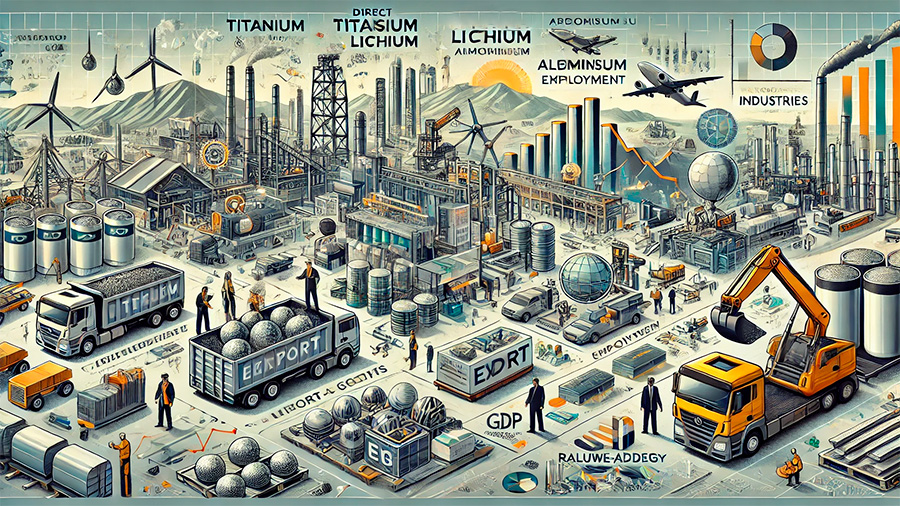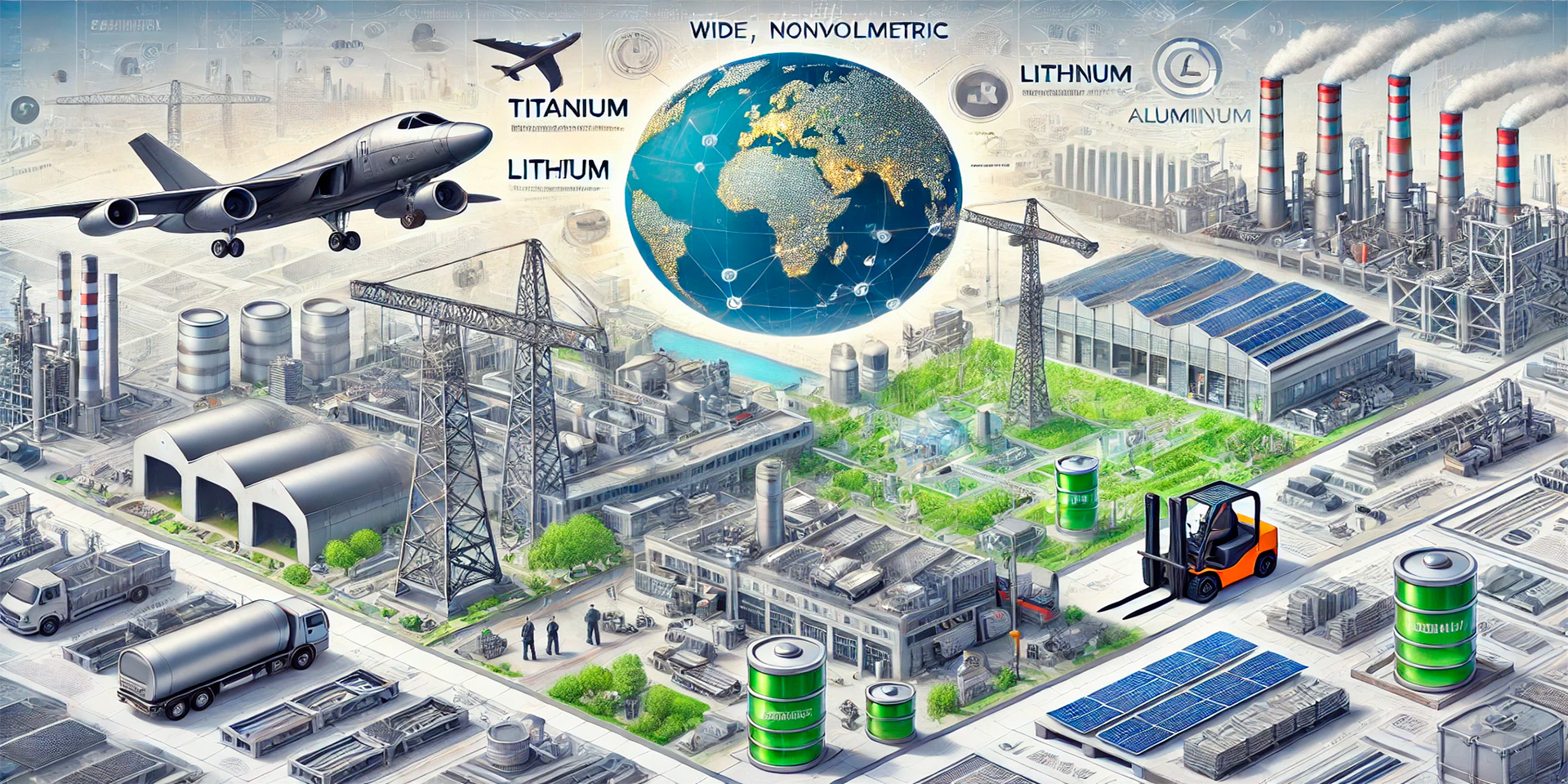Titanium, lithium, and aluminum are not just essential materials in modern industries—they are fundamental to driving economic growth and stability in many countries around the world. These metals play a critical role in sectors such as mining, manufacturing, energy, and high-tech industries, where they are used in everything from aerospace to electronics. This article explores how titanium, lithium, and aluminum contribute to national economies, stimulating GDP growth, creating jobs, and boosting technological advancements.
The Economic Significance of Titanium, Lithium, and Aluminum
These three metals—titanium, lithium, and aluminum—are integral to a range of industries, each offering unique benefits that drive demand in both domestic and international markets. The demand for these metals has grown as countries increasingly shift toward high-tech, sustainable, and energy-efficient technologies. As a result, the extraction, production, and processing of these metals have become critical contributors to the global economy.
1. Titanium: Powering Aerospace and High-Tech Industries
Titanium is one of the most valuable metals in the world due to its strength, lightness, and resistance to corrosion. These qualities make it indispensable in high-performance applications, particularly in aerospace, defense, and manufacturing industries. The growing demand for lightweight materials, particularly in the aerospace and automotive industries, has significantly increased the role of titanium in the global economy.
Economic impact of titanium:
- Aerospace and defense: Titanium is essential for manufacturing aircraft, spacecraft, and military equipment. The aerospace industry alone accounts for a substantial portion of global titanium demand, contributing significantly to GDP growth in countries that lead in aerospace production, such as the United States, Russia, and the European Union.
- Medical and industrial applications: Titanium is also used in medical devices, such as implants and prosthetics, as well as in chemical and power industries, further driving its economic contribution.
- Job creation: Titanium extraction, processing, and manufacturing create high-paying jobs, particularly in mining regions, fostering local economic growth and stability.

2. Lithium: Fueling the Green Economy
Lithium has become one of the most important metals in the 21st century, particularly due to its role in the production of rechargeable batteries. With the shift toward electric vehicles (EVs), renewable energy storage, and portable electronics, lithium is at the heart of global efforts to reduce carbon emissions and transition to a greener economy. The growing demand for lithium has stimulated economies around the world, especially in countries with rich lithium deposits such as Argentina, Chile, and Australia.
Economic impact of lithium:
- Electric vehicle (EV) production: Lithium is a key component of lithium-ion batteries used in electric vehicles, which are poised to dominate the global automotive market. The transition to EVs has led to significant investments in lithium mining and processing, driving growth in related industries.
- Energy storage and renewable technologies: Lithium-ion batteries are also used for energy storage, crucial for renewable energy systems like solar and wind power. As nations pursue clean energy goals, the demand for lithium continues to soar.
- Economic diversification: Countries rich in lithium resources are seeing diversification in their economies. For instance, Chile and Argentina have capitalized on their lithium reserves to attract foreign investment, develop new industries, and create jobs.
3. Aluminum: Enabling Growth in Manufacturing and Infrastructure
Aluminum, one of the most widely used metals in the world, plays a key role in manufacturing, infrastructure, and consumer goods. Its light weight, corrosion resistance, and versatility make it indispensable in industries ranging from automotive and aerospace to construction and packaging. As global demand for infrastructure, electric vehicles, and consumer electronics rises, aluminum continues to be a critical driver of economic activity.
Economic impact of aluminum:
- Manufacturing and construction: Aluminum is used extensively in the construction of buildings, bridges, and transportation infrastructure. As urbanization accelerates globally, the demand for aluminum in construction materials fuels economic growth.
- Automotive and electric vehicle production: The automotive industry has increasingly adopted aluminum to reduce vehicle weight and improve fuel efficiency. This trend is particularly strong in the production of electric vehicles, where lighter materials are essential for enhancing battery efficiency and overall performance.
- Job creation and industrial growth: The aluminum industry is a significant employer in many countries, with jobs spanning from mining to smelting, manufacturing, and recycling. The growth of aluminum demand has spurred the development of new industries and infrastructure projects, contributing to GDP expansion and local employment.

How These Metals Stimulate GDP Growth and Employment
The mining, processing, and manufacturing of titanium, lithium, and aluminum provide direct and indirect contributions to national economies. These metals stimulate economic growth by generating income, creating jobs, and attracting investment in both local and global markets. The industries that rely on these metals drive innovation, expand trade, and strengthen fiscal policies, all of which enhance GDP and support long-term economic development.
1. Direct Contribution to GDP
The mining and production of titanium, lithium, and aluminum represent significant sectors within national economies. The extraction and processing of these metals contribute directly to a country’s GDP, particularly in resource-rich nations. For example, Australia’s lithium sector has seen exponential growth, directly boosting its GDP and positioning the country as a global leader in the mining industry.
Key contributions to GDP:
- Export revenues: Countries that mine and export titanium, lithium, and aluminum gain substantial export revenues, which contribute to economic growth and the national balance of trade.
- Value-added industries: The processing of these metals into finished products—such as aerospace components, battery packs, and automotive parts—adds value to the economy, further increasing GDP.
- Tax revenue: Governments benefit from increased tax revenues from industries related to mining, production, and manufacturing, which can be reinvested into infrastructure, education, and other public services.
2. Job Creation and Employment Opportunities
The mining and manufacturing industries associated with titanium, lithium, and aluminum are significant sources of employment, both directly within the industries themselves and indirectly in supporting sectors such as logistics, engineering, and retail. As demand for these metals grows, the number of jobs in extraction, processing, and related industries expands, further benefiting national economies.
Job creation in metal industries:
- Mining jobs: Direct employment in mining operations provides jobs for local populations, especially in rural and underserved areas, contributing to regional economic development.
- Manufacturing jobs: The processing and manufacturing of metals into finished products create thousands of jobs in industries like aerospace, automotive, and electronics.
- Support services: Ancillary industries such as transportation, logistics, and research and development also benefit from the growth of the metal industry, expanding job opportunities across the economy.
3. Technological Advancements and Innovation
The demand for titanium, lithium, and aluminum is closely linked to the advancement of technology, particularly in sectors like renewable energy, electric vehicles, and aerospace. As industries innovate, they require these metals to drive technological progress, which, in turn, stimulates further economic growth.
How innovation drives economic benefits:
- Electric vehicle and renewable energy development: Titanium, lithium, and aluminum are crucial for the production of advanced electric vehicles, energy storage systems, and renewable energy technologies, driving innovation in sustainable industries.
- Advanced manufacturing techniques: The growing need for precision and advanced materials in sectors such as aerospace and telecommunications is boosting research and development in the metallurgy and manufacturing sectors.
Conclusion
Titanium, lithium, and aluminum are essential drivers of economic growth and technological innovation, contributing to GDP expansion, job creation, and long-term financial stability. These metals play a critical role in high-tech industries such as aerospace, automotive, energy, and electronics, where they are central to meeting global demand for sustainability and innovation. Governments and industries around the world are increasingly investing in the development of these metals, recognizing their vital role in fueling economic progress and securing a sustainable future. By leveraging the economic potential of these metals, nations can ensure a competitive edge in the global marketplace, improve employment rates, and stimulate growth across diverse sectors.
